2022.07.03.50
Files > Volume 7 > Vol 7 No 3 2022
Study the expression rate and methylation of TIMP-3 gene in the blood samples of people suffering from gastric cancer

Zahra Karimi Shahrivar 1, Elham Moslemi 2,*
1 Department of Biology, East Tehran Branch, Islamic Azad University, Tehran, Iran
2 Department of Biology, East Tehran Branch, Islamic Azad University, Tehran, Iran.; Email: [email protected]
* Correspondence: [email protected] ; Tel.: 989123355872
Available from: http://dx.doi.org/10.21931/RB/2022.07.03.50
ABSTRACT
TIMPs inhibit the necrosis factor converting enzyme of alpha tumor and induce planned cellular death. Methylation in TIMP3 promoter would cause tumor progress in cancer. The present research seeks to study the expression rate and methylation of the TIMP3 gene in the blood of individuals who have gastric cancer.
The present research uses MS PCR and Real-time PCR to study the expression rate and methylation of the TIMP3 gene, which has recently attracted much attention in gastric cancer. In this research, we have compared the blood samples of those with gastric cancer and ordinary people among Iranian patients. The expression rate of TIMP3 in the blood samples obtained from those who have gastric cancer has decreased significantly compared to the blood samples obtained from ordinary people. A significant correlation was also observed between the expression rate of this gene, age and methylation in gastric cancer. Methylation and expression levels of the TIMP3 gene were statistically significant in patient samples compared to healthy subjects, and decreased methylation and increased expression of this gene in healthy individuals indicated the role of altered gene expression in gastric cancer.
Keywords. Gastric cancer; TIMPs; Methylation; Real-time PCR.
INTRODUCTION
Gastric cancer is one of the most common types among men and women, with no apparent cause. Gastric cancer is caused by the uncontrolled growth of malignant cells in the stomach over a long period, but it has no symptoms in its initial phases. That is the reason why its diagnosis is challenging 1. Tissue inhibitors of metalloproteinases (TIMPs) are the only Matrix metalloproteinases (MMPs) inhibitors that control their activities. By consolidating tumor necrosis factor (TNF) alpha in cells, TIMPs inhibit the necrosis factor of alpha tumors and induce planned cellular death 2. The TIMP family has the following four members in all mammals: TIMP1, TIMP2, TIMP3, and TIMP4. Of all TIMPs, TIMP3 possesses the most extensive inhibition range 3. TIMP3 has an independent angiogenesis activity compared to its inhibition for MMPs 4. TIMP3 is directly connected to the VEGF receptor and blocks VEGF activity by connecting with the VEGF-2 receptor in endothelial cells 5. Thus by preventing interstitial matrix damage or by inhibiting VEGF connection to the VEGF receptor, the TIMP3 gene inhibits angiogenesis tumor development and invasion and malignancy 6, 7. As a result, disabling the TIMP3 gene through methylation may play a significant role in the invasion and development of tumors in cancer (8). Although carrying out research to identify inherited markers prone to cancer is essential for better managing this disease, investigating methylation and expression of the TIMP3 gene and its correlation with cancer have not been thoroughly studied.
It was the first time that correlation between expression rate and methylation of TIMP3 gene was evaluated in Iranian samples with gastric cancer, and the result of this study is significant for the Iranian epigenetic population study.
Research design
A case-control study was performed at the Department of Biology (Islamic Azad University), Tehran, Iran, between January 2017 and January 2018.
Study subjects
In this research, as many as 50 venous blood samples (25 healthy cases and 25 cases with gastric cancer 5 ml from each sample) were obtained from Masoud Medical Diagnostic Laboratory of Tehran.
Laboratory analysis
RNA extraction and cDNA synthesis
Following the standard protocol specified in the kit, the RNA extraction kit of Sinagen Co(Cat No: PR891620). (Iran) was used for RNA Total extraction. To synthesize cDNA, 1μl dNTP 10Mm, 1μl Random Hexamer (40Mm) and 1μl Oligo dt purchased from Sinagen Co. and 10μl purified RNA was added to the microtube. The microtube was first exposed to a temperature of 65 ℃ for 5 minutes; then, it was heated to 4 ℃ for 1 minute. Next, 2μl MMULV 10X buffer and 0.5μl MMULV (200U/ μl) was added to the tube. Then, DEPC water was used to increase the total volume to 20μl. The tube was then exposed to a temperature of 42 ℃ for 1 hour. In this research, we used glyceraldehyde-3-phosphate dehydrogenase as an internal control.
Real-Time PCR
The proliferation of Timp3 and GAPDH genes to measure gene expression by Real-Time PCR was relatively based on the standard method. The reaction tube contained 10μl SYBR TM(2X) Master Mix, 0.5μl Primer (10μM) Forward, 0.5μl Reverse Primer (10μM), 2μl RT Reaction Solution (cDNA), and 7μl dH2O, and the final volume was 20μl. Primer Express designed the sequence of primers used for Timp3 and GAPDH genes, then its accuracy and specificity were confirmed using NCBI and Gene Runner. The designed primers are presented in (Table 1). Real-time PCR was repeated three times for each sample so that the results may have high accuracy and precision. The following thermal program was defined for PCR reaction: one cycle of exposure to a temperature of 95 ℃ for 10 seconds, 5 seconds of exposure to a temperature of 95 ℃, and 45 cycles of exposure to a temperature of 60 ℃ for 34 seconds.

Table 1. Sequence and properties of specific primers of Real-Time PCR.
To study the specificity of primers and fluorescence color (cyber green) to ensure the proliferation of exclusive pieces and check for the absence of non-exclusive pieces in PCR product, melting curve graphs were drawn separately for timp3 and GAPDH genes (by PCR Real-time ABI 7500). After the proliferation reaction, the ct of samples was calculated by machines and converted to RQ (Relative Quantification). Gene expression rate was measured using the Ct method.
Genomic DNA extraction
DNG kit made by Sinagen Co (Cat No: DN8118C). (Iran) was used to extract genomic DNA due to the standard protocol accompanying it. The extraction product was run on 1% agarose gel for verification.
DNA methylation reaction was carried out using the K1461 kit (Thermo Scientific) with due observation of the standard protocol in the kit.
MS PCR reaction
MSPCR reaction was carried out by adding 12.5μl 2x master, 1μl forward primer, 1μl reverse primer, and 8.5μl distilled water to the microtube in a total volume of 25μl. The primers used for this reaction are presented in (Table 2). The following thermal program was defined: initial denaturation in a temperature of 93 ℃ for 3 minutes and then 93 ℃ for 30 seconds, the annealing temperature of 54.4 ℃ for 30 seconds, and extension in a temperature of 72 ℃ for 40 seconds in 35 cycles. In the end, the final extension was carried out at a temperature of 72 ℃ for 5 minutes. Finally, MS PCR results were run on 1% agarose gel.

Table 2 Sequence of methylated and non-methylated primers used in MS PCR(12)
Statistical analysis
The statistical methods were performed using SPSS software (version 18.0; SPSS Inc, Chicago, IL, USA) by using t-test, one-way and two-way ANOVA analysis. A p<0.05 was considered to indicate statistical significance.
Ethical clearance:
The Research Committee has approved the study at the Islamic Azad University, Tehran. 28330522941004 All subjects were informed of the study protocol in written and verbal form and provided written informed consent.
RESULTS
RNA extraction and Real-Time PCR
Eppendorf spectrophotometry machine was used to confirm the light absorption results of RNA extracted so that they could be used in the cDNA synthesis phase in 260 and 280 wavelengths with 1.7 to 1.9 densities. The real-time PCR reaction was carried out on both normal and sick samples. The normal sample was used as a reference sample to compare changes between patients. (Figures 1A & 1B) represent Timp3 and GAPDH gene proliferation curves in healthy and ill samples.
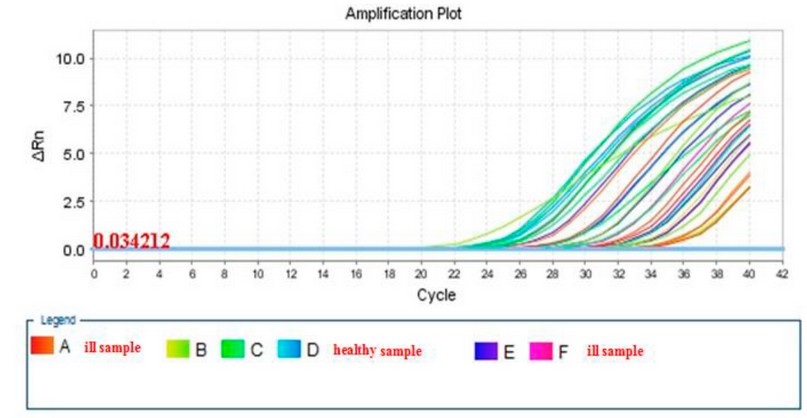
Figure 1. The linear curve of Timp3 gene proliferation in healthy and ill samples
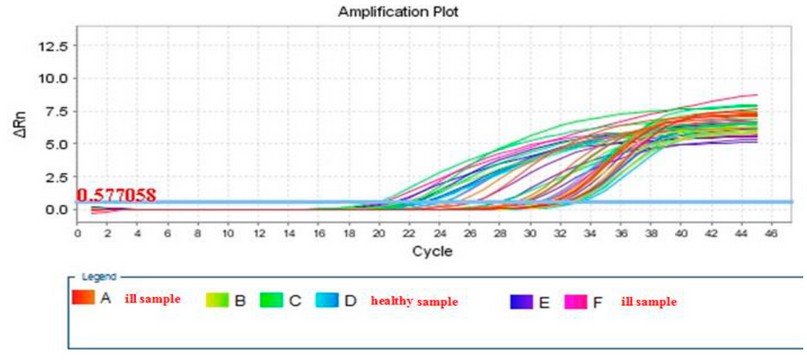
Figure 2. The linear curve of GAPDH gene proliferation in healthy and ill samples
The expression rate of sick samples was compared against standard models. The results represent the expression of the same gene compared to what was observed in the blood of ordinary people (Figure 2).
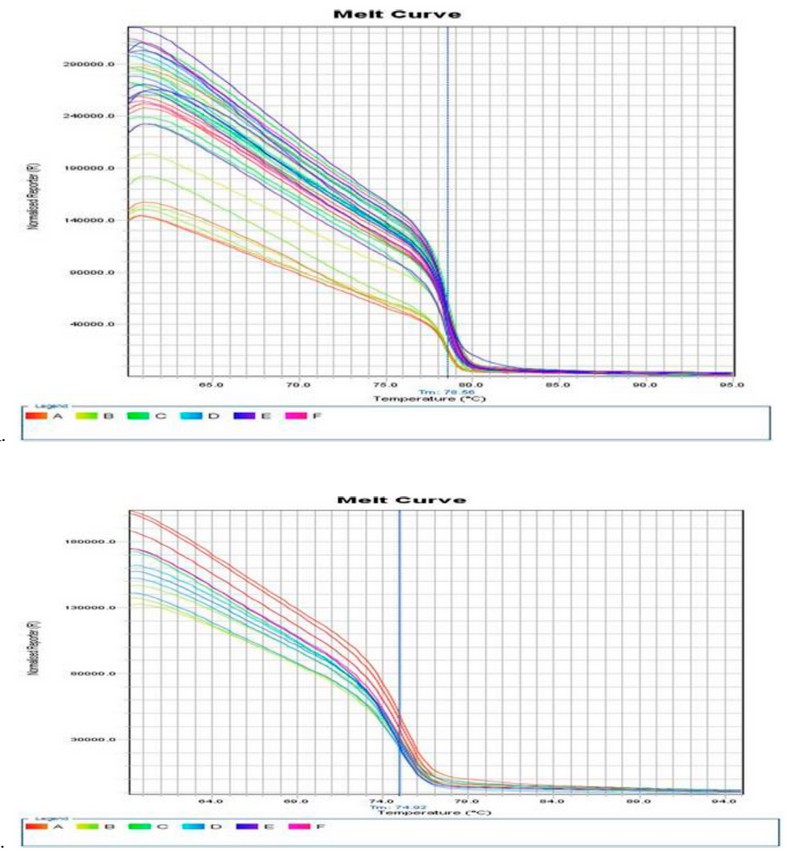
Figure 3. GAPDH gene melting curve in normal and patient samples A) Timp3 gene melting curve in normal and patient samples B)
The results of the expression rate of the TIMP3 gene and the RQ graph analysis of samples studied for the TIMP3 gene indicate a reduction in this gene expression in all samples obtained from sick subjects compared to the standard sample (chart 1. A). The mean expression rate of this gene in standard samples is much more than what was recorded for all samples.
Considering analysis of mean RQ of normal and ill samples in (chart 1-B). (1.800 and 0.4962 respectively), we can see that the expression rate among normal individuals has increased significantly compared to ill samples because Timp3 gene is active in the body as a suppressor and reducing a tumor inhibitor may cause a disease.
Figure 4- A: TIMP3 gene expression analysis in sick samples and comparing them against normal subjects (P-value < 0.0001) and B) comparing patients and normal subjects (P-value < 0.0001).
A review of the results of the expression rate of the TIMP3 gene based upon age (chart 2A) points to the fact that the mean RQ among patients compared to normal subjects is 0.5451 for those younger than 53 and 1.083 for those older than 53. This classification is done without considering disease stages and people's gender. It is done only based on age (with a significant difference).
The results of reviewing the expression rate of TIMP3 gene-based upon gender and mean RQ among men and comparing it against female patients yields 0.8942 and 0.7343, and this rate is much less among women than what we see among men (no significant difference was found in this comparison) (Figure 4).
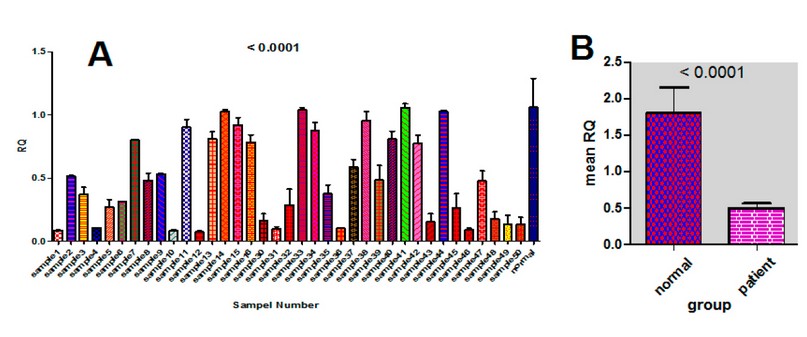
Figure 4 A: Expression rate of TIMP3 gene based upon age (P-value = 0.0482). B) Expression rate of TIMP3 gene based upon gender (P-value = 0.6662)
MS PCR results using methylated and non-methylated primers
The results of MS PCR on methylated and non-methylated primers of TIMP3 gene (with a glance at mean RQ) point to the fact that of the whole 50 cases studied (25 patients and 25 normal cases), 27 cases were non-methylated, and 23 were methylated. A frequency of 92% has been reported for methylation among patients (Figure 5). These results show that methylation doesn't activate tumor repressing genes, but methylation shuts them down. A reduction in expression makes the individual prone to affliction with the disease.
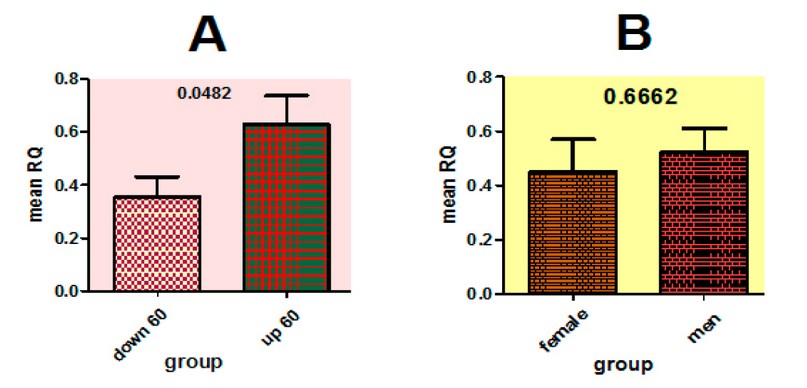
Figure 5. Mean RQ of Timp3 gene based upon gender (P-value = 0.0492)
By performing MS PCR using methylated primers and non-methylated primers on 50 samples to study the methylation status of the Timp3 gene promoter, the strips observed in the samples in Figure 6 show the methylation of the Timp3 gene promoter in these samples. In Figure 6, we see bands in non-methylated samples. The band size in all samples is in the range of 250 bp.
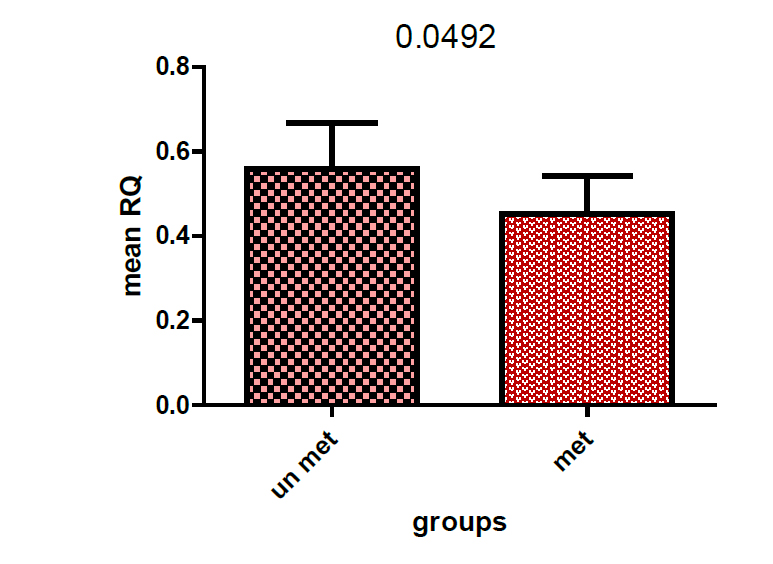
Figure 6. A sample of MS PCR results using methylated primers. The presence of bands with the size of 250 bp indicates methylation of Timp3 gene promoter (Most methylated samples were patients)
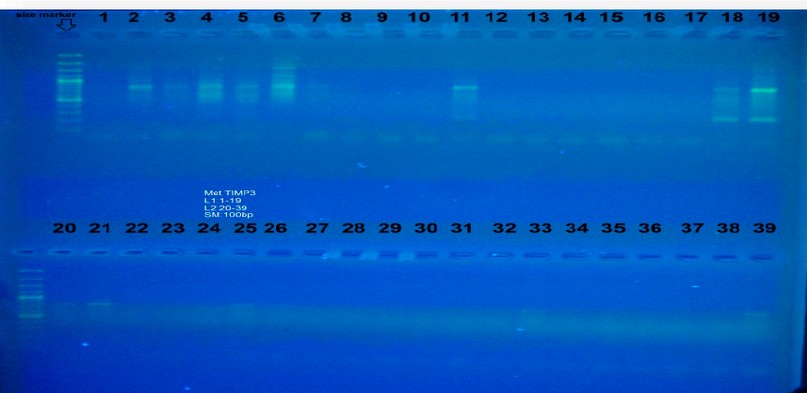
Figure 7. A sample of MS PCR results using methylated primers. The presence of bands with the size of 250 bp indicates methylation of Timp3 gene promoter (Most methylated samples were patients)
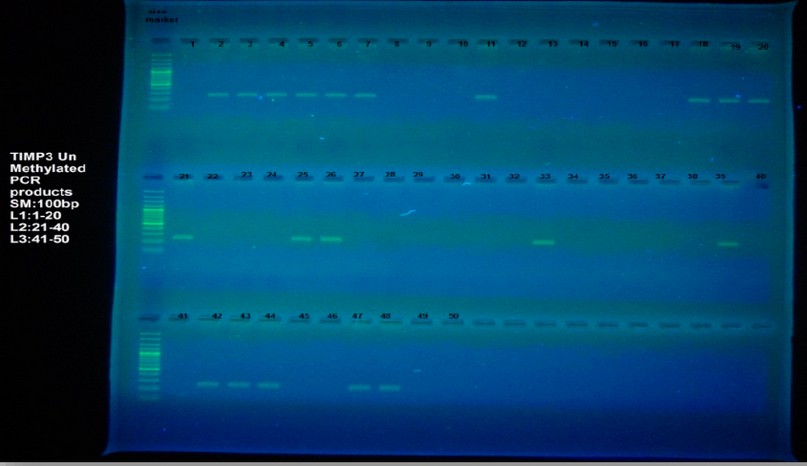
Figure 8. A sample of the results of MS PCR using non-methylated primers. The presence of bands with a size of 250 bp indicates the fact that the Timp3 gene promoter is non-methylated (Most non-methylated samples were standard)
DISCUSSION
Gastric cancer is the fifth most common cancer among all cancers, with 5.7% of all new cases attributable to the disease. Each year, over a million new cases of gastric cancer are diagnosed in the world. The epigenetic mechanism is essential for developing and preserving particular tissues' gene expression patterns among natural mammals 9, 10. Disruptions in the epigenetic procedure may cause cellular malignancies in gene functioning 11. Methylation is one of such epigenetic procedures where inappropriate changes in DNA methylation in promoter areas would deactivate tumor suppressors, which play a significant role in tumor development. Methylation of promoter CPG islands is one of the many epigenetic changes which regulate gene expression, and hyper-methylation of CPG islands of tumor-suppressing genes' promoters has been recognized in many types of cancers 12, 19. Many researchers have recently pointed out that the methylation of the TIMP3 gene promoter shuts off TIMP3, a common issue in several types of malignancies 13. Expression of this gene has been identified in response to induced Mitogenic stimulations, and this gene is the only member of TIMP's family that can connect to the extracellular matrix 14,15. Improper rise of methylation in the adjusting area of TIMP's family gene, particularly the TIMP3 gene, and a reduction in duplication would disrupt the natural performance of this gene 16. In 2019, a study of patients with endocrine tumors of the salivary glands revealed that the TIMP-3 gene had multiple mutations at different sites 17.
Shinojima et al. (2012), in another study, reported that TIMP3 was a tumor suppressor in prostate cancer, but epigenetic changes may interfere in the development of this cancer. They showed that promoter methylation was diagnosed in only 3% of low-grade and 21% of high-grade tumors 18. Guan et al. (2013) showed that CPG island's methylation in the primary mechanism of TIMP3 gene expression could be a piece of evidence for diagnosing and measuring gastric cancer. The expression rate in 70% of tumor tissues was negative, and 91.4% were hyper-methylated. Thus, there is a significant correlation between hyper-methylation and TIMP3 expression in gastric cancer 19. YU JL et al. (2014) showed that the expression rate of the TIMP3 gene among patients and normal subjects was 34.8% and 98.9%, respectively, and the methylation rate among those with cancer and normal subjects was 63.04% and 4.3%, respectively. Diagnosis of methylated TIMP3 in body fluids before operation extended the subjects' life to more than 26 months than those not diagnosed with methylation 20.
Low expression of TIMP3 is correlated with infection and the size of the tumor, histological differentiation, lymphatic invasion, venous invasion, depth of invasion, and lymph node metastasis 21. Based on various research conducted in this field, we seem to use methylated genes to diagnose people at high risk. Thus, scientists are currently paying attention to helpful tumor markers 22. Expression and methylation of the TIMP3 gene are molecular pre-awareness markers in gastric cancer. Several characteristics make it a good target for treating and inhibiting gastric cancer 23. By increasing the expression rate of the TIMP3 gene in the bodies of sick individuals, we may prevent the disease as this gene acts as a tumor suppressor, and its inhibition may cause the disease 24, 25. The present research has used the Real-Time PCR technic based upon cyber green to study TIMP3 gene expression, while MS PCR was utilized to see the methylation status of TIMP3 gene promoters. 50 samples (25 normal blood samples and 25 sick blood samples) were studied in this statistical population. The individuals who provided the samples were in various age groups and tumor stages. As our data indicate, the expression rate of this gene in the blood samples obtained from patients was much less than what was observed in standard blood samples. This data is in line with the data obtained in other research indicating that the TIMP3 gene in gastric cancer acts as a tumor-suppressing gene and that the TIMP3 gene has a lower expression rate in gastric tumor samples (26). Studying the methylation status of the TIMP3 gene promoter shows that 92% of the DNA obtained from patients is methylated, and all normal samples were non-methylated. These results align with those achieved by studying the tumor samples of stomach tissue. A significant correlation was observed between the mean expression rate of the TIMP3 gene and age and the methylation status of the promoter. Still, the correlation between the mean expression rate of the TIMP3 gene and gender was far from significant. Well-designed molecular and clinical examinations are required to target the TIMP3 gene in treating gastric cancer. The general survival of patients is the end and critical point that needs to be considered in examinations. In designing tests and confirming them, we must consider the response rate to treatment and survival rate. This requires further and authenticated investigations and studies to approve the applicability of this biomarker and its functioning in treatment.
CONCLUSIONS
Our study showed that methylation and expression levels of the TIMP3 gene were statistically significant in patient samples compared to healthy subjects, and decreased methylation and increased expression of this gene in healthy individuals indicated the role of altered gene expression in gastric cancer. Genetic diagnosis technologies to predict cancer have long been the focus of interest in many developed countries. As a result, providing a sound and rational solution to this issue and public awareness in developing countries such as Iran can be effective in reducing morbidity and mortality.
Author Contributions: ZKS was responsible for the writing of the article. EM was responsible for the submission of the report. All authors have read and approved the final manuscript.
Acknowledgments: Thanks to Masoud Medical Diagnostic Laboratory of Tehran, and Islamic Azad University, Tehran, for financial support.
Conflicts of Interest: There is no conflict of interest in this report.
REFERENCES
1. Azimzadeh P, Romani S, Mohebbi SR, Mahmoudi T, Vahedi M, Fatemi SR, Zali N, Zali MR. Association of polymorphisms in microRNA-binding sites and colorectal cancer in an Iranian population. Cancer genetics. 2012 Oct 31;205(10):501-7.
2. Moghtadaei M, Otoukesh B, Pazoki-Toroudi H, Boddouhi B, Yeganeh A. Evaluation of inflammatory response in patients undergoing surgical treatment for early and delayed femoral fractures. Archives of Medical Science. 2016. doi:10.5114/aoms.2016.63013.
3. Brew, K.; Nagase, H. The tissue inhibitors of metalloproteinases (TIMPs): An ancient family with structural and functional diversity. Biochim. Biophys. Acta 2010, 1803, 55–71.
4. Bourboulia D, Stetler-Stevenson WG. Matrix metalloproteinases (MMPs) and tissue inhibitors of metalloproteinases (TIMPs): Positive and negative regulators in tumor cell adhesion. InSeminars in cancer biology 2010 Jun 30 (Vol. 20, No. 3, pp. 161-168). Academic Press.
5. Brew K, Nagase H. The tissue inhibitors of metalloproteinases (TIMPs): an ancient family with structural and functional diversity. Biochimica et Biophysica Acta (BBA)-Molecular Cell Research. 2010 Jan 31;1803(1):55-71.
6. Brew K, Nagase H. The tissue inhibitors of metalloproteinases (TIMPs): an ancient family with structural and functional diversity. Biochimica et Biophysica Acta (BBA)-Molecular Cell Research. 2010 Jan 31;1803(1):55-71.
7. Kaschula CH, Hunter R. Synthesis and Structure–Activity Relations in Allylsulfide and Isothiocyanate Compounds From Garlic and Broccoli Against In Vitro Cancer Cell Growth. InStudies in Natural Products Chemistry 2016 Jan 1 (Vol. 50, pp. 1-43). Elsevier.
8. Qu Y, Dang S, Hou P. Gene methylation in gastric cancer. Clinica Chimica Acta. 2013 Sep 23;424:53-65.
9. Forootan M, Tabatabaeifar M, Fatemi M, Darvishi M. Efficacy of Chemoradiotherapy on Health-Related Quality of Life in Esophageal Cancer Patients with Dysphagia. Mater Sociomed. 2019 Dec; 31(4): 246-252.
10. Naseh, G., Mohammadifard, M. and Mohammadifard, M. (2016), Upregulation of cyclin‐dependent kinase 7 and matrix metalloproteinase‐14 expression contribute to metastatic properties of gastric cancer. IUBMB Life, 68: 799-805.
11. Koutresi, D.; Clarke, B.; Lotery, A.J.; De Salvo, G. Sorsby fundus dystrophy with polypoidal choroidal vasculopathy: Extending TIMP3 phenotypes. Clin. Exp. Ophthalmol. 2019.
12. Worthley DL, Phillips KD, Wayte N, Schrader KA, Healey S, Kaurah P, Shulkes A, Grimpen F, Clouston A, Moore D, Cullen D. Gastric adenocarcinoma and proximal polyposis of the stomach (GAPPS): a new autosomal dominant syndrome. Gut. 2012 May 1;61(5):774-9.
13. Wagner AJ, Remillard SP, Zhang YX, Doyle LA, George S, Hornick JL. Loss of expression of SDHA predicts SDHA mutations in gastrointestinal stromal tumors. Modern Pathology. 2013 Feb 1;26(2):289-94.
14. Arpino, V.; Brock, M.; Gill, S.E. The role of TIMPs in regulation of extracellular matrix proteolysis. Matrix Biol. 2015, 44–46, 247–254.
15. Naessens, S.; De Zaeytijd, J.; Syx, D.; Vandenbroucke, RE; Smeets, F.; Van Cauwenbergh, C.; Leroy, B.P.; Peelman, F.; Coppieters, F. The N-terminal p.(Ser38Cys) TIMP3 mutation underlying Sorsby fundus dystrophy is a founder mutation disrupting an intramolecular disulfide bond. Hum. Mutat. 2019, 40, 539–551.
16. Tan IB, Ng I, Tai WM, Tan P. Understanding the genetic basis of gastric cancer: recent advances. Expert review of gastroenterology & hepatology. 2012 Jun 1;6(3):335-41
17. Koutresi, D.; Clarke, B.; Lotery, A.J.; De Salvo, G. Sorsby fundus dystrophy with polypoidal choroidal vasculopathy: Extending TIMP3 phenotypes. Clin. Exp. Ophthalmol. 2019.
18. Shinojima T, Yu Q, Huang SK, Li M, Mizuno R, Liu ET, Hoon DS, Lessard L. Heterogeneous epigenetic regulation of TIMP3 in prostate cancer. Epigenetics. 2012 Nov 13;7(11):1279-89.
19. Guan Z, Zhang J, Song S, Dai D. Promoter methylation and expression of TIMP3 gene in gastric cancer. Diagnostic pathology. 2013 Jul 2;8(1):1
20. Yu JL, Lv P, Han J, Zhu X, Hong LL, Zhu WY, Wang XB, Wu YC, Li P, Ling ZQ. Methylated TIMP-3 DNA in body fluids is an independent prognostic factor for gastric cancer. Archives of Pathology and Laboratory Medicine. 2014 Nov;138(11):1466-73.
21. Yang Q, Zhang RW, Sui PC, He HT, Ding L. Dysregulation of non-coding RNAs in gastric cancer. World journal of gastroenterology: WJG. 2015 Oct 21;21(39):10956
22. Malekzadeh R, Derakhshan MH, Malekzadeh Z. Gastric cancer in Iran: epidemiology and risk factors. Arch Iran Med. 2009 Nov 1;12(6):576-83.
23. Nagini S. Carcinoma of the stomach: A review of epidemiology, pathogenesis, molecular genetics and chemoprevention. World J Gastrointest Oncol. 2012 Jul 15;4(7):156-69
24. Lee MH, Knäuper V, Becherer JD, Murphy G. Full-length and N-TIMP-3 display equal inhibitory activities toward TNF-α convertase. Biochemical and biophysical research communications. 2001 Jan 26;280(3):945-50 .
25. Warwick, A.; Gibson, J.; Sood, R.; Lotery, A. A rare penetrant TIMP3 mutation confers relatively late onset choroidal neovascularisation which can mimic age-related macular degeneration. Eye Lond 2016, 30, 488.
26. Reya T, Morrison SJ, Clarke MF, Weissman IL. Stem cells, cancer, and cancer stem cells. nature. 2001 Nov 1;414(6859):105-11.
Received: 13 March 2022 / Accepted: 25 July 2022 / Published:15 August 2022
Citation: Karimi Shahrivar Z , Moslemi E. Study the expression rate and methylation of TIMP-3 gene in the blood samples of people suffering from gastric cancer. Revis Bionatura 2022;7(3) 50. http://dx.doi.org/10.21931/RB/2022.07.03.50